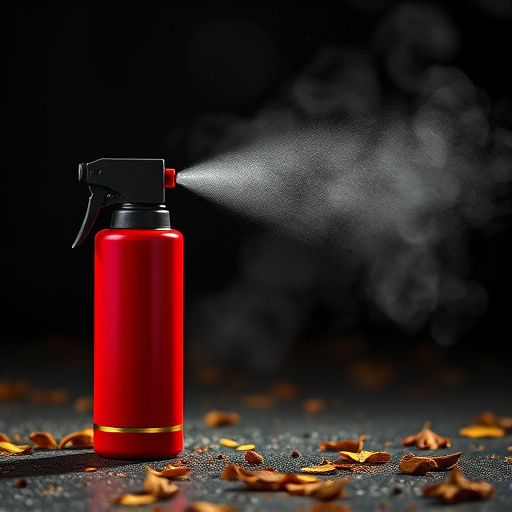Oleoresin capsicum (OC) spray, derived from chili peppers, is a powerful self-defense tool targeting the nervous system. Effective use requires training and understanding its immediate effects, such as tear production and breathing difficulties. Key immediate care steps after exposure include washing affected areas with soap and water for 15 minutes and seeking medical attention if needed. Prevention strategies involve wearing protective gear, regular cleaning of spray devices, proper storage, educating users about laws, and ensuring safe usage practices to avoid legal issues and distress.
“Uncover the power of oleoresin capsicum (OC) spray as a versatile self-defense tool. This article delves into the science behind OC spray, offering insights on its active ingredient and effective use cases. From understanding its immediate impact to learning crucial safety precautions, we guide you through the process. Discover essential care tips for those exposed to pepper spray, and explore legal considerations to ensure responsible usage. By the end, you’ll be equipped with knowledge on how to navigate this powerful defense mechanism effectively.”
- Understanding Oleoresin Capsicum (OC) Spray: The Active Ingredient
- When and How to Use an OC Spray for Self-Defense
- Immediate Care After Exposure: Treatment and Prevention Tips
- Legal Considerations and Safety Precautions for Pepper Spray Users
Understanding Oleoresin Capsicum (OC) Spray: The Active Ingredient
Oleoresin capsicum (OC) spray is a powerful defense tool that works by targeting the nervous system. The active ingredient, oleoresin capsicum, is derived from chili peppers and is known for its intense heat and irritation-inducing properties. When sprayed, OC triggers a reaction in the body, causing the eyes to water, breathing to become difficult, and pain to ensue. This immediate care for pepper spray involves washing the affected areas with soap and water, as well as seeking medical attention if severe symptoms persist or occur.
Understanding how OC spray works is crucial for users to appreciate its effectiveness as a self-defense mechanism. The spray’s ability to disrupt normal functioning of the eyes and respiratory system makes it a formidable tool against potential attackers. Proper training and knowledge on how to use OC spray safely are essential, ensuring that individuals can defend themselves effectively while minimizing risk to bystanders.
When and How to Use an OC Spray for Self-Defense
When using an Oleoresin Capsicum (OC) spray for self-defense, timing is crucial. It’s best deployed when faced with an imminent threat, giving you a split-second advantage to create distance from the assailant. Aim for the face—the eyes, nose, and mouth—as these areas are highly sensitive to the chemical irritant in OC spray. A quick, focused burst is effective, allowing you to escape without endangering serious injury.
After spraying, immediate care is essential. If possible, wash your face with soap and water as soon as safely possible. Seek medical attention if irritation persists or if you experience difficulty breathing. Always keep your OC spray charged and within easy reach, ensuring its reliability when needed most.
Immediate Care After Exposure: Treatment and Prevention Tips
Immediate care after exposure to oleoresin capsicum (OC) spray, often referred to as pepper spray, is crucial. If someone comes into contact with OC spray, it’s essential to act quickly. Start by removing any contaminated clothing and washing the affected areas with mild soap and water. This helps to flush out the irritants. For eye exposure, rinse eyes thoroughly under running water for at least 15 minutes; seek medical attention if irritation persists. Inhaling OC spray can cause respiratory distress; ensure the victim moves to an area with fresh air immediately.
Prevention is key when it comes to pepper spray exposure. Wearing protective gear, such as gloves and eye protection, during potential encounters is highly recommended. Regularly cleaning and maintaining your personal defense tools, like OC spray devices, ensures they function correctly when needed. Educate yourself and others about the proper use of these tools, including safe storage practices, to minimize accidental exposure.
Legal Considerations and Safety Precautions for Pepper Spray Users
When carrying and using oleoresin capsicum (OC) spray, or pepper spray, as a defense tool, it’s crucial to understand the legal implications in your region. Each country and state has specific laws governing the possession, use, and transportation of OC spray, with varying restrictions on who can purchase and carry it. Users must familiarize themselves with these regulations to avoid legal consequences. For instance, some areas require permit or registration for pepper spray ownership, while others have age restrictions.
Safety precautions are paramount when handling any type of spray. After using OC spray for self-defense, immediate care is essential. This includes thoroughly washing the affected area with water and mild soap to remove any residual spray. Seek medical attention if irritation or discomfort persists. Pepper spray can cause temporary blindness, so users should avoid aiming it at eyes and ensure they have adequate eye protection during use. Additionally, proper ventilation is critical to prevent inhalation of the spray, which can lead to respiratory distress.
Oleoresin capsicum (OC) spray is a powerful self-defense tool, offering immediate care and protection in potentially dangerous situations. When used responsibly, it can deter attackers and provide crucial time to escape. However, it’s essential to understand the legal considerations and safety precautions surrounding pepper spray use. After exposure, proper immediate care is vital for mitigating discomfort and preventing long-term effects. By adhering to these guidelines, individuals can maximize the effectiveness of OC spray while ensuring their well-being.
